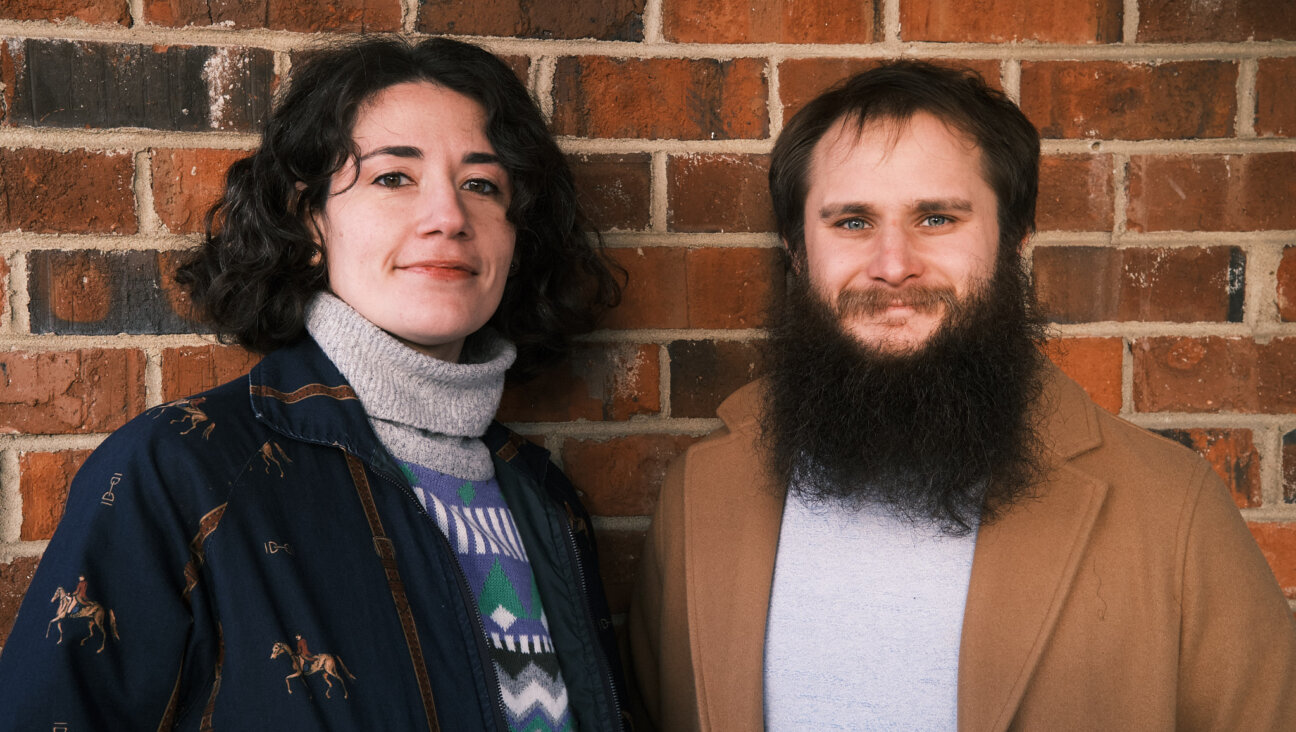The colorful stories about my ancestor from Uman, Ukraine

Graphic by Angelie Zaslavsky
In light of the ongoing war in Ukraine, I’d like to share a little bit of our own family history during a period when Ukraine had hundreds of thriving Jewish communities.
Growing up in Detroit, I heard many stories of what life was like for my family in dreym (in the old country) in Uman, Ukraine. The one person who was mentioned most often was my great-great-grandfather, Khaim Nokhem Muchnik, who lived and died in Ukraine in the time of the Russian Empire.

Khaim Nokehm Muchnik in Uman, 1912 Courtesy of Dan I. Slobin
Every descendant of Khaim Nokhem Shoykhet, as he was called (A shoykhet is a ritual slaughterer) had a version of his life story to tell. Apparently, he was a man of distinction in Uman — a rov, a shoykhet, a khazn and a moyl (a rabbi, ritual slaughterer, cantor and a circumciser). A family story, which I heard in Brooklyn from two of his daughters in their eighties, Pupa and Pesl, and in Detroit from a granddaughter (my grandmother, Sima Liepah), and from my mother, has earmarks of “birth of the hero” tales. This is what I was able to piece together:
Khaim Nokhem Muchnik was born in Uman in 1843. Early in his life he and two siblings were walking home from school and got lost in the woods for three days. Somehow his big sister got them back. After the death of his father, and perhaps also of his mother, Khaim Nokhem and his siblings were moved to Balta, where their relatives had a flour mill. This is probably the origin of the family name, Muchnik, the Yiddish word for ‘flour merchant’.
In the first half of the 19th century, under the reign of Tsar Nicholas I, Jewish communities were required to provide a quota of conscripts for the army, with an obligation for 25 years of service. They would be put into “Contanist Batallions” and trained until age 18, when their military service would begin. In the 1850s, under pressure of military needs at the time of the Crimean War, some Jewish communities made use of khapers (catchers), who seized young Jewish boys and turned them over to recruiters.
At the age of eight Khaim Nokhem was one of those boys captured. Family memory doesn’t record whether he was snatched by a Jewish khaper or by a Tsarist recruiter, but either way, he was one of a group of boys passing through the shtetl of Tolne. As the story goes, the Tolner Rebbe found out about it and bribed the recruiter to let all the boys go. The Rebbe was struck by Khaim Nokhem, who seemed to be very bright, and took him into his own home, raising him to be a rabbi – perhaps because he had no son of his own. The boy learned well and the Rebbe married him off to his own daughter, finding him a job as a rabbi in Uman. Some years later Khaim Nokhem went from Uman to Balta to arrange a wedding and give a dowry (nadn) for his daughter, Perl, known by her descendants as di Mime Perl (Aunt Pearl).
At the wedding, a woman came over and said that she recognized Khaim Nokhem, claiming him to be her brother whom she hadn’t seen for 39 years. It turned out she was indeed his sister, Nekhamah, who proved the connection by telling the story of how they had once gotten lost in the woods for three days. In the most legendary version of the story, her proof was knowing about a scar he had on his shoulder where, as a little boy in the woods, he had once been scratched by a bear, or, in a somewhat less legendary version, where he had been scratched by a dog as a child in Balta.
The other story concerns a legal conflict he dealt with when he was in his late fifties. He was facing a Russian judge in Uman, around 1900, and felt uncomfortable being in court, involved in a case that involved a neighbor and a goat. He would have preferred to settle the matter privately, but was required to testify before the judge. I’ve reconstructed his testimony from various relatives – his daughter Golda, his granddaughter Sima, and my father, who married into the family. The testimony that Khaim Nokhem gave, as it has been passed down orally for several generations, is an unintentionally humorous mixture of Russian, Ukrainian, and Yiddish. The following version is what I transcribed when my father Norval Slobin, who heard it from his mother-in-law, recited it for me:
Pany mirovóy, ya nichó ni znayu – eto moyó umglik. Di mayse derfun is azoy: Kólo méne voynt a shokhn. To on máye asóro ízim. Shtukhn bukhn in máyim dakhn. I ya yemú kazhe, a on sebje lakhn. Nu, panye mirovóy, shto vi kázhete na móyo umglik?
The key phrase in his testimony that made us all laugh, was eto moyo umglik. Eto moyo is Russian for “this is my” and umglik is Yiddish for “misfortune”. Generations later, the family would discuss whether Khaim Nokhem actually thought that the word umglik was Russian!
In any case, my great-great-grandfather was respected by the family, and apparently by the community. He produced a prodigious amount of offspring — four children by his first wife (my great-great-grandmother Sima Verzub, who was a young mother when she died of smallpox) and another 17 children or so by his second wife, di bobe Khaye (my grandmother Khaye) who survived him into the 1950s in Brooklyn, dying at age 103 or 104. Perhaps ten or eleven of these many children lived well into adulthood, settling in Brooklyn, Detroit, Montreal and Israel.
The photo above is the only one that was ever taken of him. He was frum (pious) and considered photography to be a violation of the commandment against graven images. But he gave in to the pleadings of two of his favorite grandchildren, Moishe and Oshie (Sima’s younger brothers) when they set off for America in 1913. They knew that they would never see each other again, and he consented to let them take this “graven image” with them to the New World. It’s probably why he looks so unhappy here. He died two years later.
–––––––––––
Dan I. Slobin is a retired professor of psychology and linguistics at the University of Berkeley.















